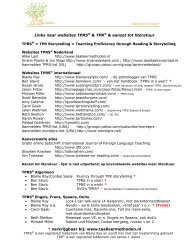TPRS in a Year - Taalleermethoden
TPRS in a Year - Taalleermethoden
TPRS in a Year - Taalleermethoden
Create successful ePaper yourself
Turn your PDF publications into a flip-book with our unique Google optimized e-Paper software.
Step One Skills: Establish<strong>in</strong>g Mean<strong>in</strong>g and Personaliz<strong>in</strong>gSkills #1 through #15 are basic skills required to do Step One of <strong>TPRS</strong>, establish<strong>in</strong>gmean<strong>in</strong>g. Most of them also directly address personalization.Skill #1: Sign<strong>in</strong>g/Gestur<strong>in</strong>gAfter you have written and expla<strong>in</strong>ed the words for the story on the board with theirtranslations but without expansion or pontification, and with no comments aboutgrammar, you have the option of mov<strong>in</strong>g <strong>in</strong>to sign<strong>in</strong>g and gestur<strong>in</strong>g.Sign<strong>in</strong>g or gestur<strong>in</strong>g the words “pumps up” the students. Much more than merelyteach<strong>in</strong>g mean<strong>in</strong>g, it immediately builds a sense of trust through fun.Imag<strong>in</strong>e that it is the beg<strong>in</strong>n<strong>in</strong>g of class and you have just written a dansé/danced.Students agree on a sign for danced and then sign or gesture it when you say it.Next structure: n’avait pas de chaussures/didn’t have any shoes. Students agree on asign for didn’t have and shoes, and then sign it when you say it.Next, simply say the expressions with lots of quick repetitions as they sign. Have agr<strong>in</strong> on your face. Enjoy yourself. Play a memory game with your students. Monitorthe barometer student, the slower one who tries (see skill 9).First sign one structure, then two together, then do the same with students’ eyesclosed to check for acquisition. If students can sign the words with their eyesclosed, they know it. If they can‟t, they don‟t know it, and they need more practice.Many <strong>TPRS</strong> teachers don‟t use this skill, f<strong>in</strong>d<strong>in</strong>g that they are able to establishmean<strong>in</strong>g quickly and directly without it. However, when done as described above,this skill br<strong>in</strong>gs to the mix of a <strong>TPRS</strong> class some wonderful th<strong>in</strong>gs:1. Mean<strong>in</strong>g is put <strong>in</strong>to the students‟ bodies via the TPR <strong>in</strong>volved, and not justtheir m<strong>in</strong>ds. As such, it is more deeply acquired and thus easier to accesslater <strong>in</strong> class dur<strong>in</strong>g the contextual flow of the story.2. Gestur<strong>in</strong>g is a fun memory game, and it creates an upbeat mood <strong>in</strong> theclassroom right away. The classes start with laughter and <strong>in</strong>terest, s<strong>in</strong>ce it isa game.3. With the “eyes closed” aspect of sign<strong>in</strong>g and gestur<strong>in</strong>g, the message is sentthat every student is go<strong>in</strong>g to have to show knowledge of the structures:“That’s great, class! Almost all of us have it, but there are still a few whoneed a little more practice with eyes closed!” The message is:



